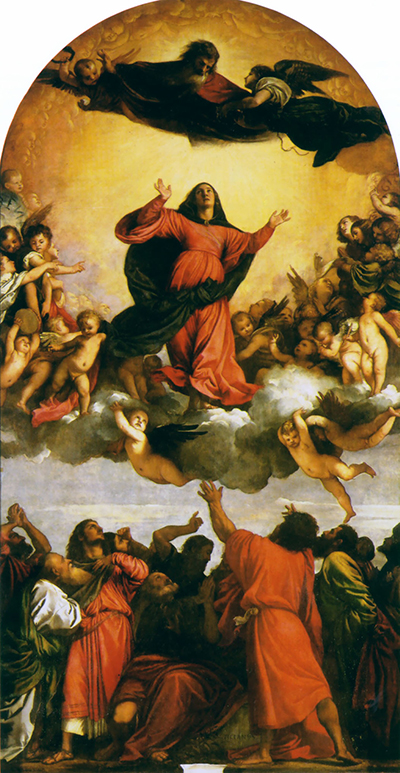Titian painted Assumption of the Virgin during the years of 1516 to 1518.
This oil on panel creation measures 690 cm by 360 cm and is housed today in the large alter space of the Basilica di Santa Maria Gloriosa dei Frari in Venice.
Titian was a famous Renaissance artist and Assumption of the Virgin was his first major piece of commissioned work. After this painting he became one of the most influential artists in Venice.
Assumption of the Virgin, was a revolutionary work of art, in that it completely broke with tradition and artistic boundaries. We see a brightly coloured painting, with larger than life characteristics, with the blessed Virgin appearing twisted and ethereal to the Apostles who stand below her gazing upwards. It was through these artistic interpretations and differences that Titian grew in popularity.
It is believed that during the unveiling ceremony for Assumption of the Virgin, that the envoy of Charles V saw the painting and was hugely impressed with its magnificence. He therefore as a consequence, urged the Franciscans present to purchase it. Marino Sanuto the Younger, also saw the unveiling.
Titian painted the Assumption of the Virgin over a two year period. He drew inspiration for this creation outside the walls of Venice. Influences from artists such as Michelangelo can be seen in the painting of the Apostles, while the overall image that is portrayed has similarities to the style of Raphael. What can be clearly seen when we observe Assumption of the Virgin is a break from the norms of Venetian art that showcase both drama and tension upon the canvas.
Assumption of the Virgin is clearly divided into three zones; top, middle and bottom. Towards the bottom of the painting we see the depiction of humanity, with the painting of the Apostles. They are looking upwards towards the blessed Virgin in sheer wonder.
We see Saint Peter kneeling upon the floor as if in prayer, and Saint Thomas can be clearly seen pointing towards the Virgin. The middle zone of the painting is dedicated to the blessed Virgin, bathed in what appears to be eternal light. Surrounding her are many angels. The top zone of the painting is dedicated to the Holy Father, his face is bathed in pure love and adoration, as he calls the Virgin towards him.
Titian originally trained as a mosaicartist artist, but we see very little evidence of this style in this painting. What we do glimpse though is that the background is bathed in a golden hue, that many art historians believe was a homage paid towards the noble tradition of the mosaic Venetian era.
The painting is vivid in both action, life sized figures and colours. Titian was most unusual, and indeed unique, in his using of oil ground paints, that were gathered mainly from linseed oil and turpentine. The scale of the figures present within the painting was also a deliberate statement, allowing the observer to see the entire image from anywhere within the Basilica.




